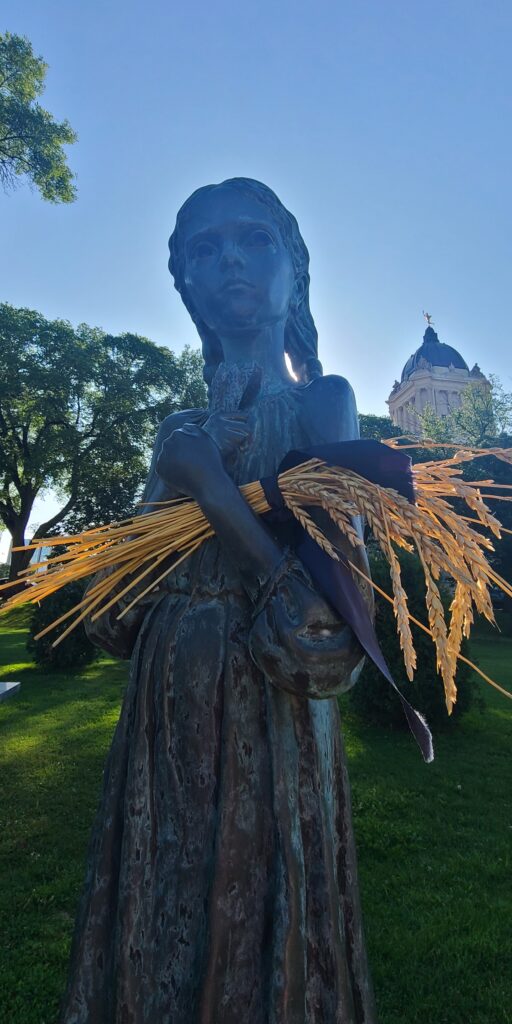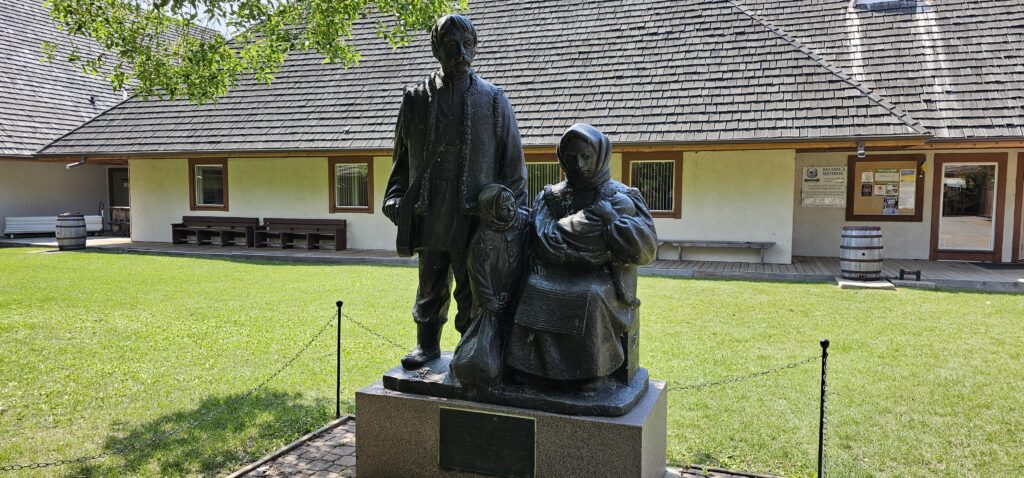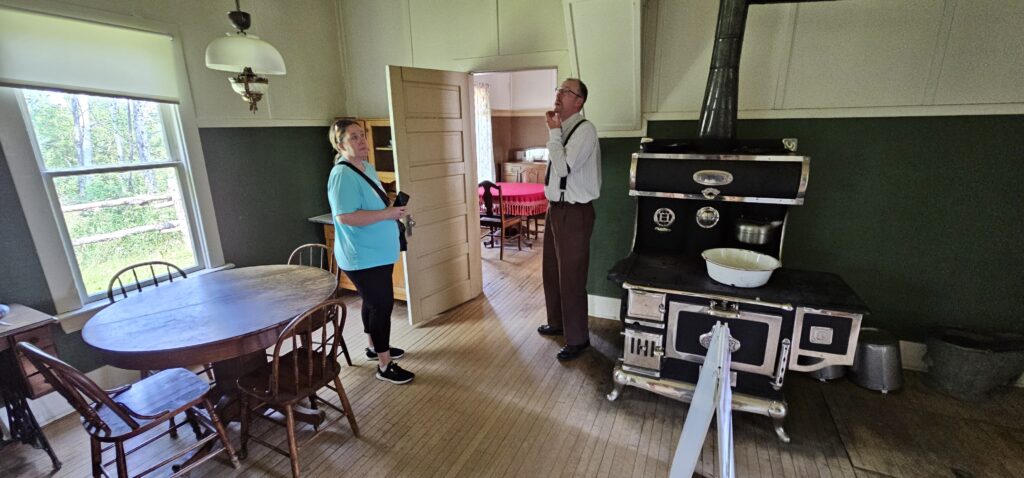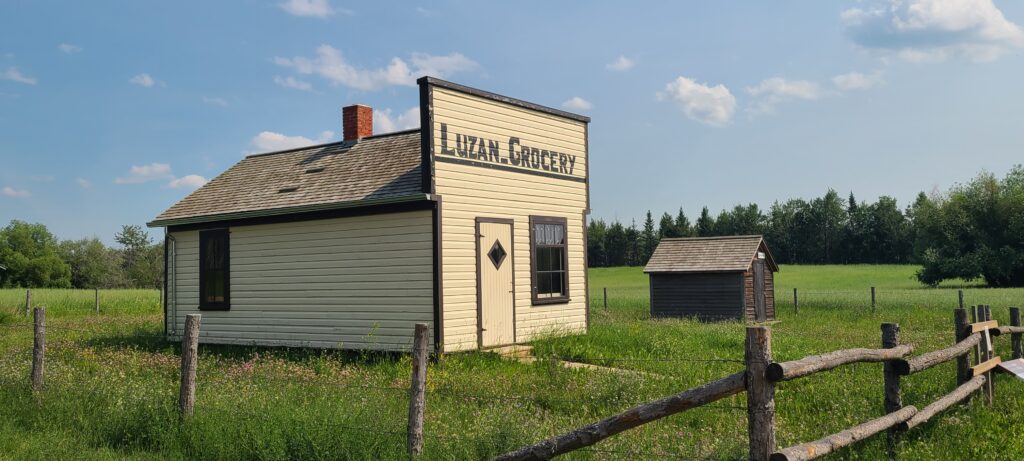I really like this image. It is one of contrast. In front, a starving Ukrainian girl who represents the oppression that Ukraine suffered from a forced famine. In the background is a poet. Tara Shevchenko is considered to be the founder of the modern Ukrainian language.

It was a real surprise to us just how much Ukraine is represented the further west we drove on our trip to Alaska and back. The presence of these people in shaping Canada is inescapable.
Our first Ukrainian-themed stop was just a couple of days before stopping here, at Kapuskasing Internment Camp, where we learned of the ill-treatment that our government did to these people during the First World War. Now, we were in Manitoba and confronted again with the harsh realities of what man does to other men.
The unnamed girl in this memorial is holding a shaft of wheat. Soviet leader Joseph Stalin weaponized a famine and used it to crush Ukrainian independence. One out of every ten would die from starvation. This genocide is known as Holodomor.
As we kept going west, we encountered Ukrainian-named towns, Ukrainian memorials and monuments and various Ukrainian-themed attractions. This was a sad reminder of that nation’s current struggle and what they have gone through in history.
We pondered this reminder called Bitter Memory of Childhood on the fifth day of our journey. Located outside the Manitoba Legislative Building, it is one of many statues, monuments and memorials that populate the surrounding yards. What brought us here was for a free tour of the Legislative Building. The inside was opulent and imposing, which was what it was designed to be, but there is this stark reminder of poverty and suffering outside. My wife and I could not but feel drawn to this statue of the girl.
I had no idea there were so many Ukrainian-themed destinations between Ontario and Alberta. During my research phase, when I was planning our trip to Alaska, it was a rough guideline that I would have about two hours of travel and then find something to do. That could be as simple as a lookout point where we admire the scenery or something more involved like touring this Legislative Building in Winnipeg. When planning my route and the locations to stop at, I was immediately impressed with the number of Ukrainian heritage destinations. Yes, there were many other ethnic groups represented as we travelled west, but what stood out was the number of Ukrainian places.
Our first encounter was the gravesite of an internment camp in Ontario. We drove right by it at first but turned around when we saw a plaque describing what the place was. To our horror, we learned that Ukrainians were imprisoned as potential spies during the First World War, much like the Japanese were in the Second World War.
This fact of forced confinement, simply because they were Ukrainian immigrants, was made all the more tragic because a previous Canadian Prime Minister invited Ukrainians to settle in the West. They were the right choice because Western Canada and Ukraine share so much alike in geography, climate and agriculture. They must have felt a sense of betrayal to be just thrown into a prison camp.
Then, to see this statue of a girl suffering in a man-made famine brought to light how much Ukraine has suffered at the hands of others.
There is also a celebration of Ukrainian heritage. While driving toward Edmonton, we saw a park with its main feature as one of those giant eggs, Vegreville Pysanka. When we arrived, a small market was happening as well. At this park, they wanted people to pose trying to pick up the egg and send it in to them. I knew it could not be done, so I didn’t try. Of course, I regret not attempting it and having the picture as a memory.

We could have easily bounced from one Ukrainian heritage location to another as we travelled west, but the sad reality is that it is impossible to see everything but instead pick and choose. The third and final location of Ukrainian-themed destinations was the heritage village outside Edmonton, only a few minutes from Elk Lake National Park.
Ukrainian Cultural Heritage Village was the best heritage village that we had been to. If you look at our Featured Map, you will see that we have been to many heritage villages. What stood this one from the rest was that there were actors in some of the buildings playing the role of Ukrainian settlers from 150 years ago.




At one particular house, I asked the woman playing the farmer’s wife how they maintain the mud hut they live in. She would tell me that it is relatively resistant to the rain but requires some maintenance. She brought us inside and talked about all her children and how many more she might be having. She showed where everyone sleeps and the large mud oven she maintains throughout the day so she can bake her bread and meals for her husband.
It was interesting to hear how often she referred to her husband, who is working hard in the fields. She stressed the importance of being a housewife back in the early years. She took pride in this job, even though she thought the husband did have it easy at times.




When her husband arrived home, another actor, I presumed, talked of all he did. My wife was so enchanted with their performance that she started to think they were early pioneers in the area. The husband kept referring to the old country. I asked him why he left the old country for here.
His answer shocked me. How he answered brought me back to the internment camp, we had passed many days prior. If anyone listened to this man, who represented the sentiments of Ukrainian settlers, there would have been no need to throw these people into prison for the duration of the war.








Yes, there are many great things about the old country, like family, friends, everyone speaking the same language, traditions, etc. But the main reason to leave was that everything in Canada was theirs. The land they owned. The cows they owned. The milk it produced, they owned. The berries in the forest free to pick. Wood to chop, theirs. In Canada, there was freedom and the freedom to succeed. In Ukraine, under the Austro-Hungarian Empire, it was a feudal system, which was just a step or two above slavery. The population owned nothing. They had to pay hefty taxes and rent and tolls for everything. Even eggs from chickens they kept had to be paid to the landlord. Coming to Canada gave them freedom and dignity not experienced in their home country.
This was the last stop that featured Ukraine as a theme. I wish I had understood the Ukrainian people’s impact on this country and the plight they needlessly suffered. We were in the first week of our six-week journey, and I wished I had added more Ukrainian destinations.
- To find this and all the other locations we have visited, check out Featured Map for directions on how to get here. Direct links are available on some of the featured sites.
- To see the original map of our Alaska trip, click here. Some of the places we could not go to (for various reasons), and some areas we added which need to be included in this map. To see those, click on the Featured Map.
- The original itinerary for this trip can be seen here. It does not include sites that we added on.







